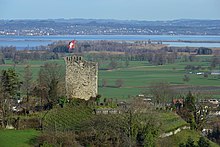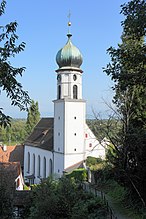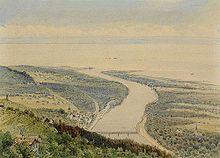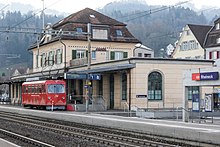Rheineck SG
| SG is the abbreviation for the canton of St. Gallen in Switzerland and is used to avoid confusion with other entries of the name Rheineck . |
| Rheineck | |
|---|---|
| State : |
|
| Canton : |
|
| Constituency : | Rhine Valley |
| BFS no. : | 3235 |
| Postal code : | 9424 |
| UN / LOCODE : | CH RNK |
| Coordinates : | 762 175 / 259526 |
| Height : | 400 m above sea level M. |
| Height range : | 395-544 m above sea level M. |
| Area : | 2.21 km² |
| Residents: | 3419 (December 31, 2018) |
| Population density : | 1547 inhabitants per km² |
| City President : | Urs Müller |
| Website: | www.rheineck.ch |
| Location of the municipality | |
Rheineck is a village and a political municipality in the cultural landscape of the St. Gallen Rhine Valley in the canton of St. Gallen in eastern Switzerland . The town belongs to the political constituency Rhine Valley .
geography
Rheineck lies between the end of the Rhine valley and the Rhine delta , about 4 kilometers before the Old Rhine flows into Lake Constance . It is located between Rorschach and St. Margrethen directly on the Swiss-Austrian border in the Germany-Austria-Switzerland triangle and is the starting point for the Rheineck-Walzenhausen mountain railway . The Old Rhine forms the border between Austria and Switzerland.
Rheineck is a regional center for the Appenzeller Vorderland and the lower Rhine Valley . In the bottleneck between the foothills of the Vorderland and the Rhine, Rheineck was of strategic importance for centuries.
Neighboring communities are Thal and St. Margrethen in the canton of St. Gallen, Lutzenberg in the canton of Appenzell Ausserrhoden and Gaissau in Vorarlberg .
history
Rheineck was first mentioned around 1163 as castellum Rinegge and in 1218 as Rinegg (copy). The Ad Rhenum mentioned on the Tabula Peutingeriana is suspected by recent research not in Rheineck, but in St. Margrethen.
In Carolingian times , Rheineck belonged to the Reichshof Thal . Around 1163, Count Rudolf von Pfullendorf received the Thal court and thus Rheineck as a fief from the Bishop of Constance . At the same time he bought the castellum Rinegge from the bishop , which can perhaps be identified with the castle and today's ruins of Alt-Rheineck. Neu-Rheineck Castle was built in the 13th century, destroyed in 1445 and its ruins demolished in 1747. Walls connected the castles with the town. This consisted of only two rows of houses and had three gates. In 1208 the Abbey of St. Gallen and the Diocese of Constance quarreled over the court, which in 1209 became the Imperial Bailiwick . The privileges confirmed by King Rudolf I in 1276 promoted urban development. In 1291 a ferry to Gaissau , 1312 an Ammann , 1340 a weekly market, 1424 a schoolmaster is attested. The town hall was built from 1553 to 1555. The Lords of Rheineck, ministerials of the Bishop of Constance and the Abbot of St. Gallen, mentioned from 1169 to 1365, temporarily held office . In 1309 Rheineck was given to Count Hugo III as pledge. von Werdenberg-Heiligenberg , it was by Leopold III. conquered by Habsburg and, under changing rule, got caught up in the turmoil of the Appenzell Wars and later the Old Zurich War . After the victory over the Habsburgs near Wolfhalden in 1445, the Appenzell people destroyed Rheineck and brought it under their rule together with the Rheintal Bailiwick, which they had acquired until 1460 . After the Rorschach monastery collapsed in 1489, Rheineck was the main town of the federal governorate of the Rhine Valley from 1490 to 1798 . In 1544 the high court was moved from the road against Thal to the Rhine near Buriet. From 1798 to 1803 Rheineck belonged to the Lower Rhine Valley district in the Helvetic canton of Säntis , from 1803 to 1831 to the Rhine Valley district in the newly founded canton of St. Gallen and from 1831 to 2002 to the Lower Rhine Valley district . From 1831 to 1861, Rheineck and Berneck alternated as meeting places for the district court and the district community .
Ecclesiastically Rheineck belonged to Thal. The Rheineck St. Jakob chapel was mentioned in 1433. After the Reformation , the majority of Rheineck accepted the new faith. Today's Jakobskirche, which was rebuilt in Baroque style in 1722, dates from the early 16th century. The Reformed parish founded in 1716 finally broke away from Thal in 1809. Until the construction of the Catholic Church of St. Theresa in 1932/33 and the founding of the parish, the church was used equally. Approx. From 1550 to 1634 there was a Jewish community. In 1608 it numbered 15 to 25 and in 1631 65 to 90 people. The patronage lay with the governor. There is no evidence of a synagogue , but no later than 1632 a rabbi and schoolmaster. As early as 1608, the five Catholic towns applied for the dissolution of the community, which increased noticeably in 1632 due to immigration from the Landgraviate of Stühlingen . In 1634 the Jews had to move away and some of them were accepted into the Hohenems Jewish community in Vorarlberg .

Rheineck and Thal lost their rights in 1498, and the Allmend division in Buriet did not take place until 1770. Between the 16th and 19th centuries, most of the country estates on the mountainside near Rheineck were owned by merchants from St. Gallen . Viticulture was practiced here until the late 19th century. Rheineck, privileged with customs and stacking rights from the High Middle Ages , lived primarily from transit trade. With the processing of an average of 600 rafts per year, the municipality was the most important transshipment point for goods from Chur until the middle of the 19th century . Grain and salt for the Rhine Valley and Appenzell were imported via Lake Constance . The trade in raw material ( tow ) for canvas production also ran via Rheineck . In the 18th century, the textile trade with Italy brought an economic boom, as evidenced by the stately Löwenhof, which the merchant Johannes Heer had built from 1742 to 1746. From 1826 to 1629 Sebastian Heer and JC Dalwig ran the first weaving machine factory in Switzerland together with English mechanics . Due to a lack of water, Heer relocated the associated mechanical weaving mill to Vorarlberg. The Thal-Rheineck silk gauze factory was founded in 1831 and, as Sefar AG, manufactured so-called monofilament precision fabrics in 2009 . The two Custer banks from the early 19th century went bankrupt in the 1860s and 1930s, respectively.
The silicification of the Alpine Rhine bed , increasingly also at Rheineck in the 19th century, together with the opening of the Rorschach – Chur railway in 1858, led to the collapse of traditional industries, whereas gravel extraction was of certain importance from 1870 to 1940. In the 19th century, Rheineck also fought against the diversion of the Rhine for fear of economic losses. This took place in 1900 with the Fussacher breakthrough and put an end to the flooding in the village. The municipality, which is only located on the old Rhine , campaigned for the maintenance of shipping traffic with Lake Constance. In the 1920s and 30s it became a popular destination for Lake Constance paddle steamers . From the 1860s to the 1970s, the embroidery and silk industries offered income opportunities. A sticker school existed from 1899 to 1925. The cantonal agricultural school Custerhof, established in 1896, was converted into a farmer's school in 1977 and in 2004 it was affiliated to the cantonal vocational and advanced training center as a home economics education center. Local traffic was opened up in 1860 with the stagecoach to Heiden, 1869 to Thal and 1871 to Walzenhausen, to which there has also been a mountain railway connection since 1896 . The Rhine bridge replaced the ferry in 1874. In 1964 Rheineck was connected to the A1 .
population
| year | 1634 | 1850 | 1900 | 1950 | 1970 | 2000 | 2010 | 2018 |
| Residents | 548 | 1177 | 2094 | 2600 | 3275 | 3231 | 3325 | 3419 |
| source | ||||||||
traffic
Rheineck is on the main road St. Gallen / Kreuzlingen – Rorschach – St. Margrethen – Chur and has an exit from the A1 motorway . With a commuter share of 63% and 66% respectively in 2000, Rheineck suffers from heavy through traffic.
The station on the Rorschach – Chur railway line serves public transport and is served by the S2, S3 and S4 of the St. Gallen S-Bahn . From the Rheineck train station, the mountain railway leads to Walzenhausen , the scheduled boat to Rorschach and postbus lines via Thal and Altenrhein to Rorschach, to Heiden and St. Margrethen . From the Rheineck train station, the “ Gaißau in Vlbg Staatsgrenze” stop can be reached in 10 minutes on foot , from which the Postbus takes travelers to Bregenz .
Attractions
- Old town, with half-timbered houses, early modern buildings and Art Nouveau houses
- "Alte Landschreiberei": four-storey solid and half-timbered building, dated from 1639, possibly older, as it was built on the site of the old Rinegge Castle (also the Schlössli , see below)
- Old office building: the former seat of the governors, stylistic symbiosis between Gothic and early Baroque, built around 1580
- Old primary school building: Late Classicist property in private ownership, built in 1881 by Gustav Adolf Müller
- Castle plateau: level above the old town with a view of Lake Constance, the Allgäu Alps and the Bregenz Forest
- Burgstock: castle ruins (watchtower) from the 12th century
- «Custerhof»: Baroque building with a mansart roof and elaborate rococo structures inside, built between 1750 and 1753
- Evangelical parish church St. Jakob : founded in the Middle Ages, preserved choir from the new building in 1519, renovated in Baroque style in 1722, restored in 1980/1981
- “Behind the market”, formerly also known as “Judengasse”: the oldest surviving quarter, as it was largely intact from the fire in 1876
- Catholic St. Theresienkirche: built in 1932/1933 according to plans by Otto Linder , one of the first modern church buildings in Switzerland
- “Löwenhof”: Palais with a French garden in front with orangery, fountain and pavilion, built 1742–1746
- Upper school building: Classicist building in neo-baroque style, built in 1905/1906 according to plans by Adolf Gaudy
- Town hall: built from 1553 to 1555, renovated and rebuilt in 1876 and 1929/30, with stepped gable and wooden square turret, inside including paintings by Heinrich Herzig
- Rhytor (Rheintor): the last preserved city gate from the 15th century with a half-timbered structure and painting by Heinrich Herzig
- «Schlössli»: on the site of the old Rinegge Castle, which was destroyed around 1445 , a group of buildings from the 17th century consisting of 5 parts
- Weiergasse: street along the former city wall with partially preserved remains of the fortifications
Personalities
- Rudolf II von Werdenberg-Rheineck (1370–1420), count and freedom hero
- Johann Heinrich Custer (born December 21, 1757 in Altstätten , † October 24, 1818 in Rheineck), yarn and linen dealer
- William Wolfensberger (1889–1918), pastor and poet.
- Heinrich Herzig (1887–1964), artist (especially painter)
- Walter Rüsch (* 1906 in Rheineck; † 1983 in Locarno ), musician and musicologist
- Hansruedi Züst (1921–2005), electrical engineer, television pioneer and director of the Swiss radio and television company
- Hans Letsch (1924–2015), politician (FDP), born in Rheineck.
- Markus Kühnis (* 1955 in Rheineck), organist, arranger and music teacher
Web links
Individual evidence
- ↑ Permanent and non-permanent resident population by year, canton, district, municipality, population type and gender (permanent resident population). In: bfs. admin.ch . Federal Statistical Office (FSO), August 31, 2019, accessed on December 22, 2019 .
-
↑ a b c d e f g h Peter Müller, Markus Kaiser: Rheineck. In: Historical Lexicon of Switzerland .
These sections are largely based on the entry in the Historical Lexicon of Switzerland (HLS), which, according to the HLS's usage information, is under the Creative Commons license - Attribution - Distribution under the same conditions 4.0 International (CC BY-SA 4.0). - ↑ Permanent and non-permanent resident population by institutional structure, place of birth and nationality. On: bfs.admin.ch. Federal Statistical Office (FSO), accessed on June 18, 2020.
- ↑ 881 Wil SG - St. Gallen / Herisau - St. Gallen - Altstätten SG (all trains). In: Official course book, timetable year 2020
- ↑ Timetable. On the website of the Austrian Federal Railways (ÖBB), timetable year 2020
- ^ Wolfgang Göldi: Johann Heinrich Custer. In: Historical Lexicon of Switzerland .
- ↑ Walter Rüsch on ticinarte.ch











